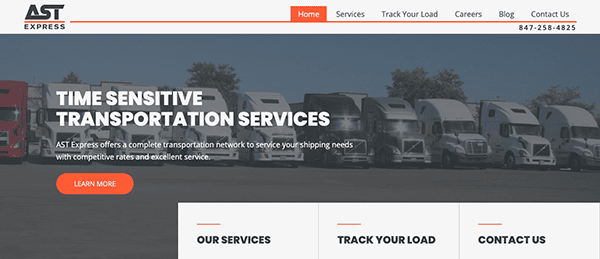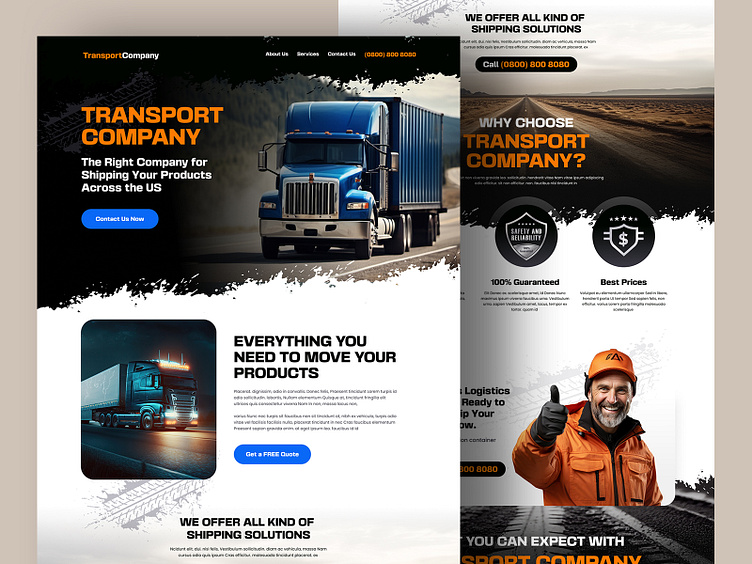Exactly How Specialized Transportation Internet Style Helps Improve Customer Interaction and Conversion
In today's competitive landscape, specialized transportation internet style plays a pivotal function in enhancing customer interaction and driving conversion prices. By concentrating on user-centric features, these websites not just improve navigating however additionally adjust perfectly to numerous gadgets, guaranteeing ease of access for all customers. The strategic combination of visual aspects and clear call-to-action prompts can significantly affect individual behavior. As we explore the essential parts that add to an effective design, it ends up being noticeable that understanding these components can bring about transformative outcomes for businesses in the transportation field. What particular strategies have verified most reliable?
Value of User-Centric Layout
In today's electronic landscape, a user-centric style is extremely important for specialized transportation web platforms - transportation web design. This technique focuses on the needs and choices of users, improving their overall experience while browsing complicated transport solutions. By concentrating on usability, availability, and instinctive navigating, companies can cultivate a feeling of depend on and integrity amongst customers, which is vital in the transport field
User-centric layout entails comprehensive research study to recognize the target audience's habits, motivations, and challenges. This knowledge informs the growth of attributes such as structured reservation processes, easy access to solution details, and receptive client support. Furthermore, personalization can be integrated to deal with specific customer choices, causing enhanced engagement and complete satisfaction.
Implementing a user-centric design not just boosts the performance of transportation internet systems but additionally improves conversion rates. When customers discover a system very easy to navigate and responsive to their needs, they are much more likely to complete deals and return for future solutions. Eventually, a well-executed user-centric design adds to the overall success of specialized transport organizations by improving customer loyalty and motivating repeat company.
Influence of Visual Components
While the functionality of a specialized transport web platform is important, the influence of visual aspects can not be overlooked. A well-designed aesthetic layout plays a critical role in recording user attention and facilitating information retention. Efficient usage of color, typography, and images not only boosts the aesthetic charm yet also communicates brand name identity and expertise.
Visual elements, such as top notch pictures of transportation solutions, can stimulate trust and integrity, encouraging prospective customers to involve additionally. Infographics and symbols simplify complicated info, making it extra digestible. This clarity can bring about reduced bounce prices and increased time invested in site, both of which are favorable indications of individual involvement.
Moreover, a consistent visual pecking order overviews customers through the internet site flawlessly, ensuring that vital info-- such as service offerings, prices, and call information-- is conveniently obtainable. This strategic arrangement helps to route possible customers towards preferred actions, such as filling in a contact form or asking for a quote.

Mobile Responsiveness Benefits
The value of visual aspects encompasses mobile responsiveness, which is significantly important in today's electronic landscape. As more individuals accessibility websites with smart phones, a responsive design makes certain that content is shown ideally across various display dimensions. This adaptability not only enhances customer experience however additionally significantly effects client involvement and conversion prices.
Mobile responsiveness permits specialized transportation companies to meet the assumptions of a diverse clientele. Users are much more likely to stay on a site that is easy to navigate on their smartphones or tablet computers, leading to longer session durations and lowered bounce prices. In addition, a mobile-friendly layout constructs reputation; customers are a lot more inclined to depend on and involve with a business that emerges well on all gadgets.
Furthermore, online search engine like Google prioritize mobile-optimized websites in their ranking formulas. transportation web design. Consequently, businesses that purchase mobile responsiveness can enhance their visibility and bring in even more organic website traffic. This raised exposure can convert right into higher conversion prices, as potential customers are more probable to call or book solutions through a website that functions flawlessly on their smart phones. Thus, mobile responsiveness is an essential element of effective internet design in the specialized transportation sector.
Streamlining Navigation Experience

A well-structured navigating experience is critical for specialized transportation websites, as it directly affects individual interaction and contentment. When possible customers see these websites, they anticipate to find out locate details quickly and efficiently. A streamlined navigation system can significantly improve this process, directing users seamlessly through various services, prices choices, and contact info.
To attain ideal navigation, it is necessary to classify material rationally. Using a clear power structure-- such as key and second food selections-- assists individuals discern where to locate details info without feeling overwhelmed. Furthermore, incorporating drop-down menus can provide fast access to subcategories, reducing click depth, which is essential for maintaining user attention.
Moreover, a search feature enables individuals to bypass navigation completely, dealing with those that understand precisely what they look for. Carrying out breadcrumb trails can better improve the user experience by supplying an aesthetic pathway back to previous pages, enhancing website link framework.
Including mobile-friendly navigation is equally crucial, as several individuals access specialized transport web sites on their smartphones. By prioritizing an instinctive and receptive design, organizations can ensure that their web site properly serves varied user requirements, ultimately boosting client engagement and conversion prices.
Incorporating Call-to-Action Techniques
Effective call-to-action (CTA) techniques are vital for directing users toward desired end results on specialized transportation web sites. These strategies not only enhance individual engagement however likewise dramatically improve conversion prices. CTAs need to be strategically put throughout the website, guaranteeing they are conveniently noticeable and easily accessible.

Including urgency in CTAs, such as limited-time deals or unique deals, can better inspire users to act immediately. A/B testing like it various CTA styles and placements can provide useful insights into what resonates ideal with the target market.
Moreover, making certain that CTAs are mobile-friendly is paramount, as a significant section of customers may access the website via smart phones. transportation web design. By thoughtfully integrating these strategies, specialized transportation sites can efficiently direct individuals via the conversion funnel, eventually bring about increased client interaction and effective end results
Conclusion
Finally, specialized transportation website design dramatically enhances client involvement and conversion by focusing on user-centric features, integrating impactful visual aspects, and guaranteeing mobile responsiveness. Streamlined navigation experiences and well-integrated call-to-action techniques additionally add to a seamless user journey. By dealing with the certain demands of the target audience, these style concepts cultivate an atmosphere for bring in possible customers and inevitably raising conversion rates. Effective web layout hence functions as a vital element of successful transportation services.